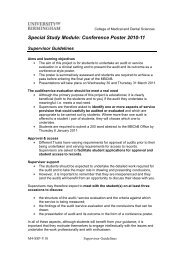Contents - College of Medical and Dental Sciences - University of ...
Contents - College of Medical and Dental Sciences - University of ...
Contents - College of Medical and Dental Sciences - University of ...
Create successful ePaper yourself
Turn your PDF publications into a flip-book with our unique Google optimized e-Paper software.
The 11 th International Workshop on KSHV & Related Agents, Birmingham, UK<br />
Clinical & Epidemiology Abstract 53<br />
KAPOSI’S SARCOMA-ASSOCIATED HERPESVIRUS SEROCONVERSION AND<br />
SEROREVERSION IN A MATERNAL-INFANT COHORT IN ZAMBIA<br />
Veenu Minhas, 1 Kay L. Crabtree, 1 Janet Wojcicki, Tendai J. M’soka, 2 Chipepo Kankasa, 2<br />
Charles D. Mitchell, 3 <strong>and</strong> Charles Wood 1<br />
1 Nebraska Center for Virology, School <strong>of</strong> Biological <strong>Sciences</strong>, <strong>University</strong> <strong>of</strong> Nebraska<br />
Lincoln, Lincoln, NE USA; 2 Department <strong>of</strong> Paediatrics <strong>and</strong> Child Health, <strong>University</strong><br />
Teaching Hospital, Lusaka, Zambia; 3 Department <strong>of</strong> Pediatrics, <strong>University</strong> <strong>of</strong> Miami<br />
School <strong>of</strong> Medicine, Miami, FL USA.<br />
Abstract<br />
Zambia is currently experiencing an HIV-1 epidemic leading to an increase in the<br />
incidence <strong>of</strong> Kaposi’s sarcoma among adults <strong>and</strong> children. This is a prospective study<br />
designed to investigate Kaposi’s sarcoma-associated herpesvirus (KSHV) seroincidence<br />
<strong>and</strong> associated risk factors for KSHV seroconversion <strong>and</strong> seroreversion in a mother-infant<br />
cohort, by following them for 48 months after delivery. Our results show that overall<br />
KSHV seroincidence in KSHV negative Zambian women was 0.7 per 100 person-months<br />
which was lower as compared to children followed in the same cohort. We observed that<br />
up to 40% <strong>of</strong> Zambian children in this cohort may be infected by 48 months <strong>of</strong> age,<br />
indicating that primary infection occurs mostly in early childhood. HIV-1 infection was<br />
associated with higher risk for seroconversion in women <strong>and</strong> children. In adult women,<br />
KSHV seroconversion was not associated with most socio-economic factors, sexual habits<br />
or medical history. This indicates that sexual transmission during adulthood may not be<br />
an important route <strong>of</strong> transmission in this cohort.<br />
Our laboratory has earlier reported that KSHV antibodies may not persist over time in<br />
children <strong>and</strong> that seroreversion leading to partial or complete loss <strong>of</strong> KSHV antibodies is<br />
prevalent. We observed seroreversion in up to 55% <strong>of</strong> women <strong>and</strong> this was more<br />
common in single women <strong>and</strong> in women delivering for the first time. These results<br />
demonstrate that multiple longitudinal samples per patient may be required to accurately<br />
determine KSHV infection status.<br />
Presenting author Email: veenu@bigred.unl.edu<br />
80















